Remember a decade ago when one in three Americans believed the cloud was either those actual fluffy, white things in the sky or something related to the weather? Cloud computing has come a long way since then.
Today, nearly all businesses are using the cloud. Firms of all shapes and sizes use several cloud computing technologies, from storage and containers to cloud computing platforms. The mass adoption of the cloud has made the space exciting and fast-moving.
To help C-suite executives, IT leaders, and business decision-makers keep up with industry-shaping cloud computing trends, study the latest statistics and insights on cloud computing. Knowing these trends helps make strategic decisions about how your businesses can use the cloud.
Top 7 cloud computing statistics for 2025
- 94% of enterprise organizations use cloud computing.
- Over 60% of all corporate data is in cloud storage.
- Global spending on cloud services will reach $1.3 trillion in 2025.
- Amazon Web Services(AWS) dominates the cloud market, with a 31% market share in 2024.
- Companies waste as much as 32% of their cloud spend.
- Over a third of cloud data breaches resulted from misconfiguration or human error.
- 83% of enterprise CIOs planned to repatriate at least some workloads in 2024.
Cloud computing growth and adoption statistics
Imagine a network of computer servers in a remote location. You don’t have to manage the infrastructure, but you can buy and use the servers whenever you like via the Internet.
This on-demand delivery of computing services such as servers, storage, databases, networks, software, or analytics solutions is called cloud computing.
It has evolved from simple cloud storage solutions like Google Drive to enterprise-grade computing services that fall into three main categories: infrastructure as a service (IaaS), software as a service (SaaS), and platform as a service (PaaS). These cloud solutions have various purposes, including data storage, analytics, software development, testing, deploying virtual desktops, building customer-facing web applications, and disaster recovery and data backups.
Take a look at these cloud computing growth statistics to understand the technology's significance and how it is dominating enterprise IT infrastructure.
Cloud-first is the mantra
- All companies use at least one public or private cloud.
- 94% of enterprise organizations use cloud computing in their operations.
- 89% of companies use multicloud infrastructure.
- 59% of businesses use multiple public clouds.
- Over 60% of all corporate data is in cloud storage.
149 zettabytes (ZB)
of data was expected to be created, captured, copied, and consumed in 2024.
Source: Statista
Cloud is becoming the IT
- Enterprise spending on cloud infrastructure services totaled $270 billion in 2023.
- Global spending on cloud infrastructure services grew 21% to hit $82 billion in the fourth quarter of 2024.
- 65% of organization increased their cloud budgets and 31% kept hem steady in 2024 despite economic uncertainities.
- 51% of IT spending will shift to cloud solutions from traditional IT tools by 2025.
- 29% of a company's IT budget is exclusively spent on cloud services and infrastructure.
- 75% of tech leaders are building all new products and features in the cloud.
- Globally, there are nearly 12 million buyers of cloud infrastructure.
Cloud adoption shows no slowdown despite economic uncertainty
- Cloud service providers, operator and vendor revenues reached $427 billion in the first half of 2024.
- Global spending on cloud services will reach $1.3 trillion in 2025.
- 4 out of 5 enterprises plan to increase their cloud investment despite economic uncertainties.
- 75% of enterprises are focusing on developing cloud-native applications.
- 70% of organization is defaulting to cloud-based services when upgrading or purchasing new technical capabilities.
- Over 50% of IT leaders indicated a willingness to migrate either consumer or corporate financial data to the cloud.
- 19% of IT leaders plan to migrate all consumer data to cloud and another 18% intend to migrate all corporate financial data to cloud solutions.
Cloud users need assistance
- 90% of organizations experienced challenges in their cloud adoption journey.
- Budgetary concerns emerged as the most significant obstacle, impacting 48% of companies.
- 41% of IT decision-makers need support from cloud vendors for security expertise, and 40% need help managing their cloud better.
Möchten Sie mehr über Cloud-Plattform als Dienst (PaaS) Software erfahren? Erkunden Sie Cloud-Plattform als Dienst (PaaS) Produkte.
Cloud computing benefits statistics
Cloud offers speed, scalability, and flexibility. At the same time, it saves resources. Businesses can quickly get the computing resources they need and deploy them in minutes - be it storage, databases, data lakes, virtual machines, etc. Look at Cloud computing offers several business advantages.
On-demand cloud service saves time, money, and resources
- 60% of organizations note that cloud capabilities helped their company achieve increased and sustainable revenue in the past year.
- Over 40% of companies have fully achieved the expected benefits, such as improved service levels (43%), business enablement (45%), and business continuity (42%) from cloud adoption.
- 39% of enterprises have fully achieved their cost-savings goal from cloud adoption.
- 1 out of 2 firms consider the cloud a more reliable platform to run their workloads.
- Cloud improves the average time to market for their new features by 37%.
- Effective cloud usage improves application development and maintenance productivity by 38%.
- Cloud reduces downtime by about 57%.
- More than 50% of firms that migrated to the cloud note better end-user experience from apps running on the cloud.
- 60% of companies note easier IT operations and management due to migrating to the cloud.
- 71% of companies with high cloud maturity quickly adopt cutting-edge technology and innovate aggressively.
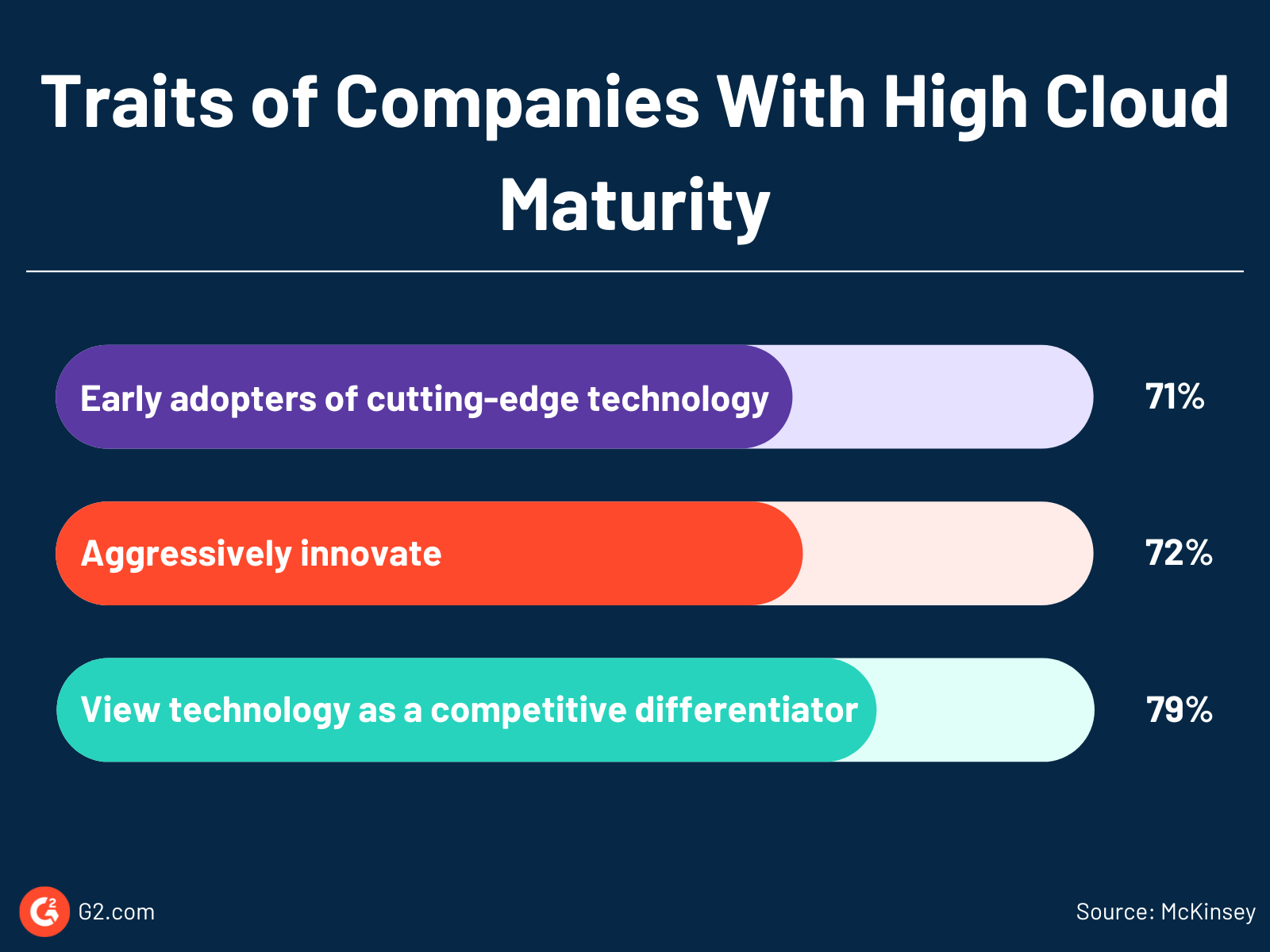
Trillions of dollars are up for grabs
- Cloud adoption could generate $3 trillion in earnings before interest, taxes, depreciation, and amortization (EBITDA) by 2030.
- Fortune 500 companies alone could realize $1 trillion in EBITDA by 2030.
Cloud computing market statistics
The advantages of cloud computing technologies have made businesses spend billions of dollars on becoming “cloud-first.” Digitization driven by remote work and the growth of new technologies like big data, artificial intelligence software (AI), machine learning (ML), and the Internet of Things (IoT) are also fueling demand for cloud based platforms.
Explore how much the cloud computing market is making and how much it will grow in the coming years.
Cloud rakes in billions
- 72% of companies spend over $1.2 million annually on the cloud.
- 36% of enterprises exceed $12 million in annual spending on cloud technology.
- Total public cloud revenues will touch $773.30 billion in 2024.
- IaaS and PaaS revenue will reach $178.80 billion and $171.80 billion respectively in 2024,
$8.4 trillion
is the valuation of the global Euroscape cloud index that includes publicly listed cloud companies from the U.S., Europe, and Israel as of 2024.
Source: Accel
- By service, SaaS dominated the cloud industry in 2023, accounting for 45% of overall revenue at $412.5 billion. SaaS is also expected to capture 40% cloud revenues in 2024.
- By deployment, private deployment constituted 47% of revenue share in 2022.
- By end-use industry, the banking, software and information services, and tetail – are the three largest sectors, collectively expected to spend $190 billion on public cloud services in 2024.
- By region, the United States is the largest public cloud market, projected to spend $432 billion in 2024.
Market valuations touch trillions in coming years
- The global cloud computing market is expected to reach $1.614 trillion by 2030, up from $446.51 billion in 2022.
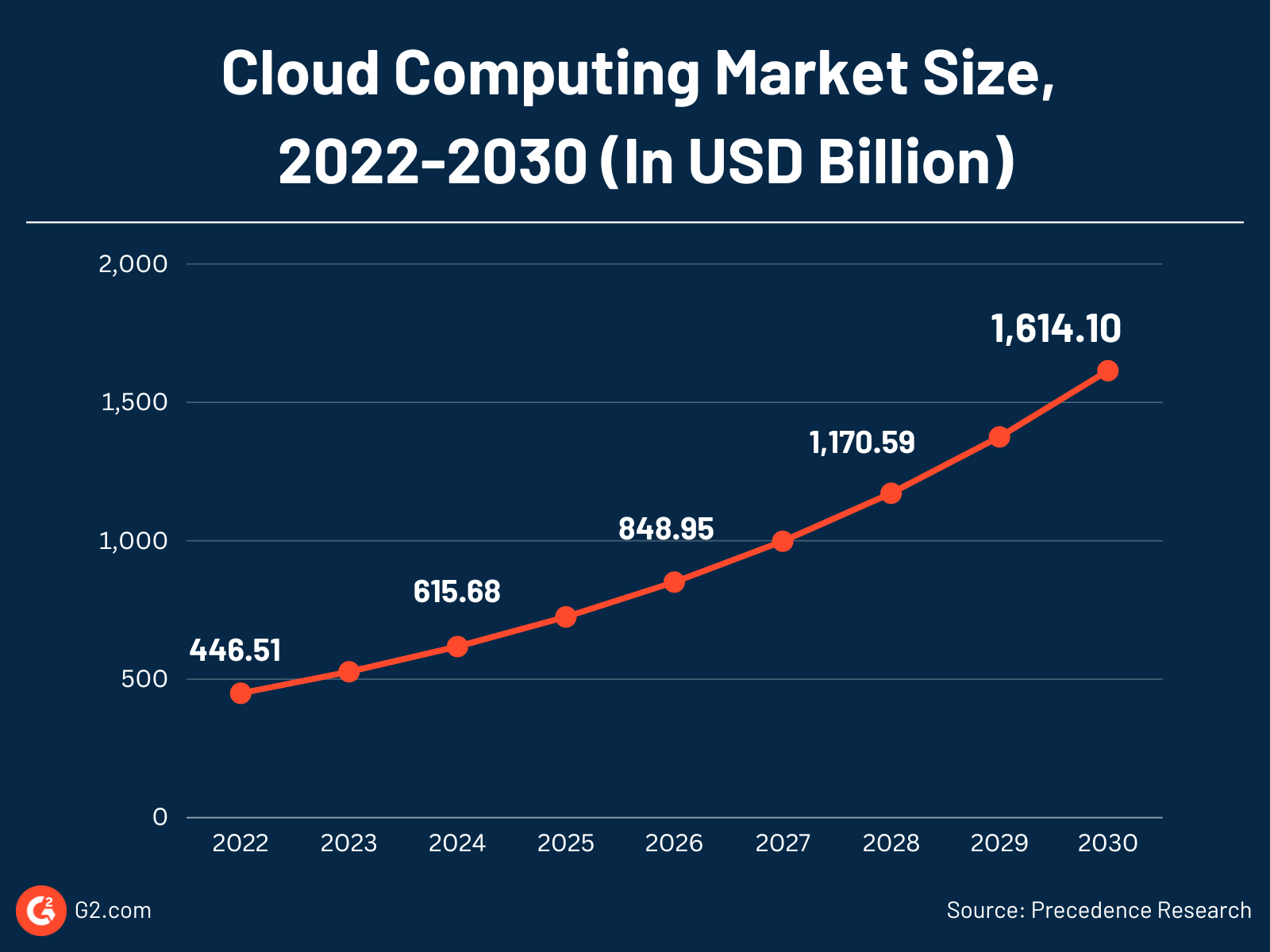
- The global public cloud market alone will more than double to $1 trillion by 2026.
By region, the U.S. is the market leader
- North America is the largest cloud computing market, is expected to reach $248.07 billion in 2024.
- The United States dominates with an expected market size of $183.57 billion in 2024.
- Europe’s cloud computing market is expected to touch $173.69 billion in 2024 and will reach $650 billion by 2032.
- The European cloud market is over five times as big as in 2017.
Asia-Pacific shows potential
- The Asia-Pacific (APAC) region, is the fastest growing market and is expected to touch $131.36 billion in 2024.
- China's public cloud market is set to reach over $121 billion in 2027, followed by Japan and Australia in distant second and third position.
Cloud market share: Who's leading?
With companies devoting billions to cloud services, competition remains intense among cloud providers to get a slice of this multi-billion dollar industry. And hyperscalers, aka large cloud providers who provide computing and storage at enterprise scale, dominate the industry, taking with them a significant chunk of cloud computing market share.
Hyperscalers rule the industry
- The 8 largest cloud infrastructure providers control over 80% of the cloud market.
- Among these hyperscalers, Amazon Web Services (AWS), Microsoft Azure, and Google Cloud dominate two-thirds (66%) of the cloud infrastructure market.
- These top three cloud providers - AWS, Microsoft, and Google - also control 71% of the public cloud market.
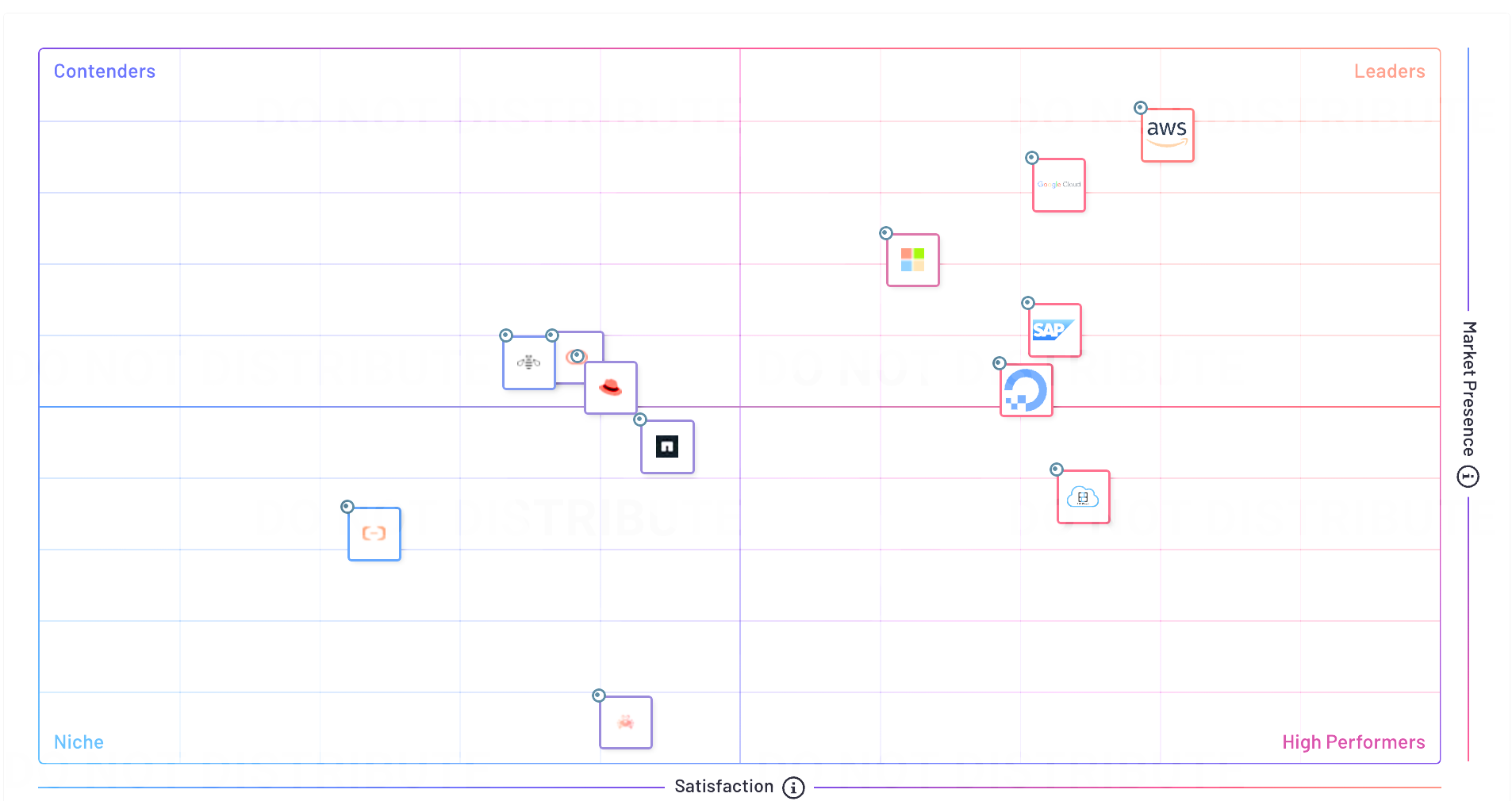
Amazon is the clear winner
- AWS is the leader in cloud infrastructure, with a 31% market share in 2024 and 19% y-o-y revenue growth. This share exceeds the combined market share of its two largest competitors, Microsoft Azure and Google Cloud.
- AWS is on track to earn $100 billion of revenue in financial year 2024.
- Microsoft Azure and Google Cloud have a 20% and 13% market share, respectively.
.png)
Public cloud statistics
Public cloud is a popular cloud deployment model where multiple organizations share computing resources provided by a vendor. These statistics show how public cloud adoption is evolving.
Public cloud adoption is accelerating
- Public cloud spending is projected to rise from $595.7 billion in 2024 to $723.4 billion in 2025.
- 97% of companies utilize at least one public cloud.
- 51% of workloads are in the public cloud as of 2024, with an additional 7% expected in the next twelve months.
- 1 out of 2 organization have data in the public cloud today, with an extra 7% expected in the next twelve months.
- Enterprises have 49% of their workloads in public cloud and 48% of data in public cloud.
- Small businesses are the biggest adopted of public cloud with 61% of workload and 60% of data in public cloud.
- The top three public cloud providers are AWS, Microsoft Azure, and Google Cloud platforms.
- Retail and e-commerce (79%), media and entertainment (73%), and software (72%) heavily use public clouds.
- 68% of small enterprises prefer the public cloud owing to its cost advantages.
Private cloud statistics
Private cloud services are a type of cloud deployment where the cloud infrastructure is exclusively dedicated to an organization, unlike a public cloud where resources are shared. The private cloud provides the added benefit of access control, security, and customization over public cloud models. Organizations handling sensitive data prefer a private cloud for enhanced data security to handle this data and meet regulatory requirements.
Private cloud usage remains strong
- Private cloud revenue will grow nearly 30% to $ 528.36 billion by 2029.
- 76% of companies use private cloud and 3% of comapnies use only private cloud for their operations.
- On average, companies run 32% of workloads in private cloud environments.
- Mircosoft Azure Stack (58%), VMware vSphere/vCenter (52%), and AWS Outposts (48%) occupy the top spots of private cloud services currently being used or experimented with.
Hybrid cloud statistics
Hybrid cloud is the natural evolution of companies using public and private clouds together with on-premise infrastructure. The technology enables the sharing and transferring of data and workloads between clouds and on-premise infrastructure. With no companies using solely public or private cloud today, hybrid cloud adoption is becoming widespread.
Hybrid cloud is on the rise
- 73% of companies have adopted a hybrid cloud approach.
- 36% of companies use multiple private and public cloud, while 29% of organizations use multiple public and at least one private cloud, indicating a strong hybrid cloud approach.
- 56% of companies with more than $500 million in revenue have adopted a hybrid cloud approach.
- 7 out of 10 IT leaders think it’s difficult to realize the full potential of a digital transformation without a solid hybrid cloud strategy.
Hybrid cloud unlocks business value
- Hybrid cloud generates 2.5 times greater business value than a single cloud platform approach.
- Businesses note that a hybrid approach enables them to achieve a more agile and scalable development environment (42%) and accelerate business agility and innovation (40%).
Multi-cloud statistics
Multi-cloud allows businesses to operate similar cloud services from different vendors in a single architecture. While it sounds similar to a hybrid cloud, there is one major difference between them. Multicloud deals with cloud deployments of the same type (either public or private) from different vendors. On the other hand, hybrid cloud deals with different types of cloud deployments.
As cloud users get more comfortable mixing and matching the cloud services from different vendors, multi-cloud is fast becoming the norm.
We live in a multi-cloud world
- 98% of enterprises use or plan to use at least two cloud infrastructure providers.
- 31% of enterprises have four or more cloud infrastructure providers.
- Nearly 9 out of 10 companies report having a multi-cloud strategy.
- Reliability (46%), digital transformation (43%), scalability (42%), and security and governance (41%) are the top reasons for companies to develop multi-cloud operations.
- 60% of IT professionals and business leaders use multi-cloud, and 47% are expanding multi-cloud use.
- More than a third of multi-cloud users are leveraging other multi-cloud software like multi-cloud security tools (32%) and multi-cloud cost management tools (31%).
- 9 out of 10 say that multi-cloud helps them achieve their business goals.
- 1 in 2 IT leaders believe organizations that do not adopt a multi-cloud approach risk failure.
Related: Learn how to harness the power of multi-cloud strategy with cloud cost management tools
Multi-cloud faces some stubborn barriers
- 4 out of 10 companies cite skill shortages as the top factor impacting their multi-cloud operations.
- More than a third say siloed teams (35%) and lack of training (33%) affect multi-cloud potential.
- 89% of companies consider automation important or extremely important for their multi-cloud infrastructure.
Cloud storage statistics
One of the most used cloud computing technologies is cloud storage. It is an alternative to on-premise data storage and hard drives that take up physical space. Cloud storage allows organizations to store large amounts of data in offsite servers that can be accessed via the web or a dedicated private network. Take a look at what users store in the cloud and how the cloud storage trends are shaping up.
Cloud storage growth is unstoppable
- Global revenue of cloud storage services reached $57 billion in 2023.
- On average, companies allocate 14% of IT budgets to public cloud storage services.
- 59% of companies use public cloud storage like AWS and file storage solutions.
- Object storage dominates cloud, with 70% of total capacity, followed by block and file storage, each at about one-third of cloud storage capacity.
For individuals, everything’s on the cloud storage
- 71% of U.S. consumers who use cloud storage store photos in the cloud.
- 53% of these consumers back up other important data in the cloud.
- 41% of store music and videos with cloud storage.
- 35% of cloud storage users store office documents in their personal cloud.
- More than a quarter of consumers (27%) use cloud storage to save their passwords and login information.
Amazon wins the enterprise cloud storage market
- Amazon Simple Storage Service S3 led the global enterprise data storage software industry in 2024, with a market share of 24%.
- Pure Storage accounted for 13% of the market share, followed by NetApp, with a 6.6% market share.
Cloud data center statistics
With increasing cloud and AI adoption, there has been an explosion in demand for data center infrastructure, the physical location that stores computing machines, storage and network infrastructure, and related hardware. Cloud providers and co-location companies are building more physical data centers to meet demand.
The data center industry is booming
- Global spending on data center construction will reach $49 billion by 2030.
- In the next four years, major cloud vendors will increase the number of hyperscale data centers by 50% and improve their data center network capacity by over 65%.
- For context, hyperscale data centers occupy at least 10,000 square feet and have at least 5,000 servers.
Once again, the U.S. is the data center market leader
- North American data center inventory grew by 24% year-over-year in Q1 2024, due to demand from public cloud providers and AI companies.
- The U.S. leads the market, with the number of data centers exceeding Germany, the United Kingdom, China, and Canada combined at 5,381. It's almost double the number of data centers it had in 2022.
- Germany and the United Kingdom follow closely with 521 and 514 data centers respectively.
- China has 449 data centers.
- Dallas, the Bay Area, and Los Angeles account for more than 100 data centers.
- Demand for data centers in the U.S. is expected to grow about 10% annually until 2030.
Data center energy consumption is a growing environmental concern
- Data centers and transmission networks each consume 1-1.5% of global electricity output and are responsible for nearly 1% of energy-related greenhouse gas emissions.
- Cooling servers account for nearly 40% of a data center’s energy consumption.
- A hyperscale data center can consume as much power as 80,000 households.
- By 2025, data centers will consume one-fifth of global electricity.
Cloud IaaS, PaaS, and SaaS statistics
IaaS, SaaS, and PaaS are the most popular and essential cloud computing services. As the names suggest, a vendor provides either the infrastructure, software, or platform as a service. The latest trends demonstrate how businesses are using IaaS, SaaS, and PaaS.
IaaS sees constant revenue growth
- IaaS spending is expected to touch $180 billion in 2024.
- 82% of IT decision markers say they currently use cloud-based IaaS to host their workloads.
- 198 IaaS providers are listed on G2, the world’s largest software marketplace.
SaaS still dominates as firms adopt more software than ever
- Companies on average use 112 SaaS apps
- An organization with 1,000+ employees adopt 3,851 distinct cloud apps, like Microsoft OneDrive, Google Drive, Amazon S3, etc.
- Companies waste over $135,000 on average due to unused SaaS software licenses.
Did you know? Salesforce is the largest publicly listed SaaS company in the U.S. stock market, followed by Adobe.
PaaS service utilization is expanding
- 65% of companies use data warehouse tools, while more than 50% of organizations utilize database-as-a-service (DBaaS) and container-as-a-service.
- More than a third of companies use PaaS services like NoSQL databases (44%), batch processing(47%), AI/ML services (41%), and stream processing (34%).
- Nearly half of the organizations are experimenting with or plan to use AI/ML tools (49%) and disaster recovery as a service (DRaaS) solutions (38%) .
- 20% of companies are experimenting with IoT tools, and another 14% plan to use them in the future.
Cloud migration trends
The cloud presents evident benefits, and companies are accelerating their cloud migration. Learn how companies are navigating their cloud migration with these statistics.
Migrating to the cloud is a top business priority
- 63% of IT decision-makers agree that their organization has accelerated its cloud migration over the past 12 months.
- The top three cloud migration challenges cited by over half of IT leaders are: understanding app dependencies (54%), assessing on-premises vs. cloud costs (46%), and assessing technical feasibility (45%).
Vendors are crucial for successful cloud migration
- 82% note that choosing the right cloud migration provider was key to their migration success.
- 41% partner with outside consultants or other service providers to identify best-fit workloads to run on public cloud infrastructure.
Ease of use is a top consideration when selecting a cloud provider
- 81% of IT decision-makers prioritize cloud solutions that are easy to use, manage, and consume when selecting a cloud provider.
- 80% of IT executives expect the best security, compliance, and support when selecting a cloud provider.
- 77% of IT leaders consider vendors’ understanding of their industry and the ability to execute migrations quickly and effectively as important selection criteria.
- Price (54%) was the least important attribute when selecting a cloud vendor, well below all other factors.
Post-migration challenges remain
- 41% face challenges when optimizing apps after a cloud migration.
- 38% of IT executives struggle with performance issues for workloads migrated to the cloud.
- More than a third struggle with training existing staff on cloud services (34%) and regulatory and compliance concerns (33%).
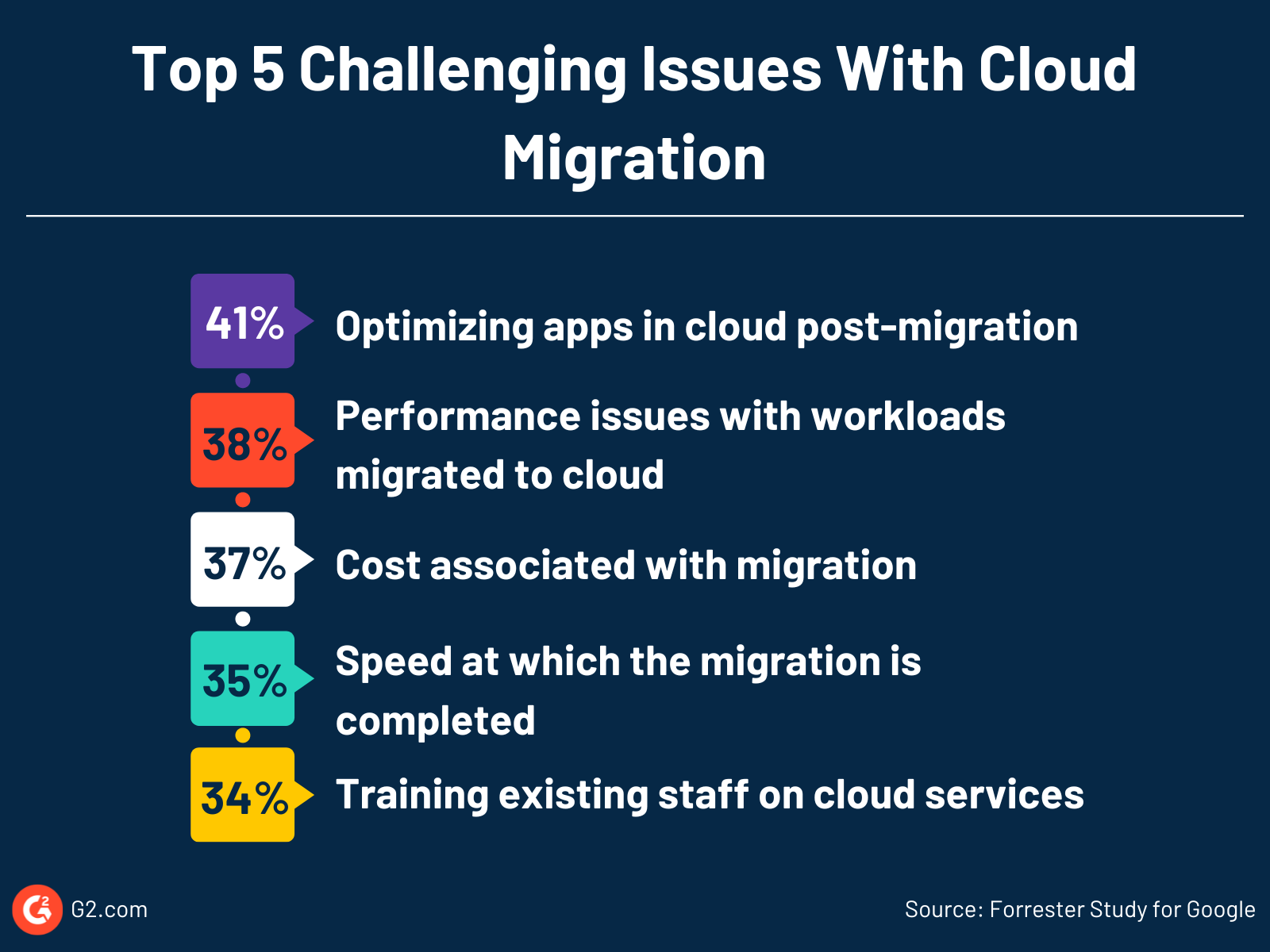
Cloud security statistics
With surging cloud migration, cloud security is emerging a top priority. Businesses are keen to ensure their cloud infrastructure and applications are secure while also protecting them against cyber attacks and unauthorized access.
Security is the top cloud challenge for the majority of organizations
- 81% of IT leaders consider security as one of the top cloud challenges.
- 47% of data on cloud is sensitive.
- Less than 10% of enterprises encrypt 80% or more of their cloud data.
- A staggering 96% of organizations are alarmed by the growing cloud security risks.
- 51% security professionals note that it is more complex to manage privacy and data protection regulations in cloud than on-premises.
- 41% of security leaders consider lack of awareness as the most significant barrier to cloud security.
- Rapid technological advancements and a shortage of skilled cybersecurity professionals are hindering organizations' ability to keep pace with evolving cloud threats as noted by 38% and 37% of security leaders, respectively.
- Poor integration and interoperability between security solutions is another significant challenge, identified by 36% of security or IT leaders.
Rising cyber attacks don’t make cloud security easier
- 61% of organizations reported breaches within the last 12 months.
- 27% of companies experienced a security incident involving their public cloud infrastructure that cost them between $1 million and $20 million USD in the past three years.
- 17% of security incidents were due to misuse of cloud services.
- Nearly 12% of cloud security incidents were due to misconfigured cloud.
- 14% of cloud security incidents were due to vulnerability exploitation.
- 31% of cloud data breaches were a result of misconfiguration or human errors.
Companies are being more proactive in cloud security
- 1 in 2 companies expects to invest in protecting applications and data on public cloud infrastructure.
- Businesses’ top cloud security priorities are threat detection and response (47%), user-education and awareness (46%) and complete monitoring (43%).
- Firewalls remain a critical component of cloud security, with 49% of organizations prioritizing them.
- Network segmentation is essential for limiting the impact of breaches, yet only 37% of organizations have effectively implemented this strategy.
-
Web Application Firewalls (WAF) and Cloud Security Posture Management (CSPM) are being adopted by 35% and 26% of organizations, respectively, to enhance cloud security posture.
Cloud spending and management statistics
As economic uncertainty looms, companies are looking for ways to reduce costs. Wasted cloud spending has become a key candidate for cost-cutting, and the numbers tell you why.
Companies are struggling to manage their cloud usage
- 66%of companies report higher cloud usage than initially planned.
- On average, an organization’s public cloud spending goes over budget by 13%.
- Companies waste 32% of their cloud spend.
- 54% of companies say that the lack of visibility into usage and efficiency is the leading source of wasted cloud spend.
1 in 4
organizations overshoot their annual projected cloud spend.
Source: Flexera State of Cloud Report
- The top reason for avoidable cloud spending is idle or underused resources (66%), followed by overprovisioning resources (59%).
- Another reason for avoidable cloud spend is the lack of needed skills (47%).
- Only 6% of cloud users say they have no avoidable cloud spend.
- More than 8 out of 10 companies consider managing cloud costs their top cloud challenge.
Related: Explore how cloud cost management software can help you control your cloud spend.
As a result, cloud management has become a priority
- More than a quarter of companies are diving deeper into cloud billing to understand current and future costs.
- Over 40% of IT professionals use automated policies to shut down workloads after hours to minimize underutilized instances.
- Another 43% perform this labor-intensive process manually.
- 39% of companies use the unit economics model to reduce their cloud cost, a vital component of the emerging FinOps discipline.
Despite these challenges, the cloud is the biggest game-changer for businesses, and its adoption shows no sign of slowing down.
Cloud repatriation trends
Given the challenges around security, cost optimization and control, there's a growing trends of cloud repatriation or companies moving their cloud workload back to on-premise servers. Here are some data on cloud repatriation that you should pay attention to:
- 83% of enterprise CIOs plan to repatriate at least some workloads in 2024.
- 37% of IT decision makers note their company has moved some app or workload from cloud to an on-premise location.
- Database, storage and backups, website and web applications and AI and ML applications are the top apps to be moved to on-premise.
While cloud repatriation sounds like moving away from cloud, this movement emphasizes the need for businesses to adopt hybrid or multi-cloud strategies that blend cloud and on-premise environments to address specific organizational needs.
Sources:
- Statista
- Deloitte
- Splunk
- Canalys
- Flexra 2024 State of the Cloud Report
- Foundry Cloud Computing Study 2024
- Accel Euroscape 2024
- Mordor Intelligence
- Zluri
- Google Cloud
- Broadcom
- Forrester Study for Google
- Cisco
- Hashicorp - Forrester
- CIO
- Markets and Markets
- Synergy Research Group
- Allied Market Research
- McKinsey
- Global Market Insights
- Canalys
- Synergy Research Group
- Grand View Research
- Precedence Research
- CRN
- Netspoke
- Anodot
- MMR
- EY
- Cisco
- Wasabi
- TechTarget
- IEA
- ET CIO.com
- BetterCloud
- CSOonline
- CheckPoint
Get on your cloud nine
In the early days, businesses worried about storing their sensitive data on the cloud and losing control and access. But today, trends have changed.
Companies are more comfortable keeping their sensitive data in the cloud. They are developing applications on the cloud. They are fast-moving to hybrid and multi-cloud models and driving innovations. They are ramping up cloud security while also optimizing their cloud spend.
Even as trends around cloud usage and adoption change, one thing is clear: businesses must go the cloud way to remain competitive and maximize their benefits.
Explore the latest cloud file storage solutions to organize all your business data in one place and simplify your storage management processes.

Soundarya Jayaraman
Soundarya Jayaraman is a Content Marketing Specialist at G2, focusing on cybersecurity. Formerly a reporter, Soundarya now covers the evolving cybersecurity landscape, how it affects businesses and individuals, and how technology can help. You can find her extensive writings on cloud security and zero-day attacks. When not writing, you can find her painting or reading.
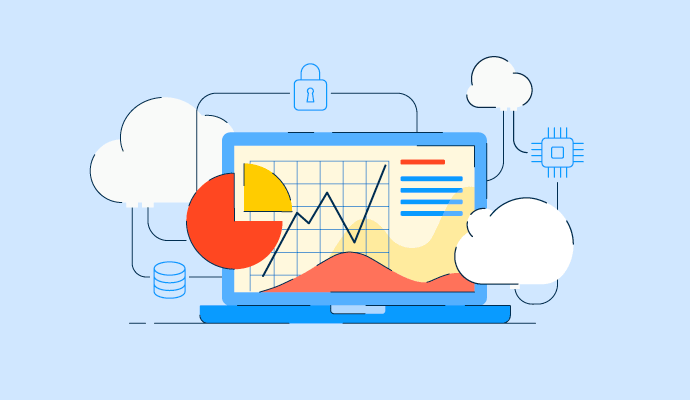
.png)
.png)